What Is RFID (Radio Frequency Identification)?
Today, we can unlock doors, make payments, and track items all with the radio technology known as RFID (Radio Frequency Identification). It uses radio waves to identify people or objects without physical contact. This technology is everywhere, from the items in your grocery store to the tags in your library books. In this article, find out what RFID is, what it does, and what RFID blocking is used for.
What is RFID?
Radio Frequency Identification (RFID) is a cutting-edge technology that uses radio waves to uniquely identify objects, animals, or humans. RFID is wireless and tracks items effortlessly without physical contact.
Radio waves are a type of electromagnetic radiation. They are used to carry information between devices. In RFID communication, changes in the amplitude of the radio waves help transmit data back and forth.
This innovative system can work over both short and long distances. The distance over which RFID works depends on factors like the type of technology used and the power of the RFID reader.
The process is similar to barcoding in that it captures data from an attached tag or label and stores it in a database.
Radio Frequency Identification technology has been in use since the early 1940s, primarily for tracking objects in military applications. However, it wasn't until the 1990s that it became commercially available. Now, the systems are more affordable and used to store or retrieve information on a wider range of everyday items.
What makes up the RFID system?
The RFID system consists of RFID tags, readers, and a backend system.
RFID tags
These tags are tiny devices attached to objects. They are comprised of a microchip or microcircuit and a scanning antenna. This circuit features a non-volatile memory, which is then responsible for storing data.

RFID tags store data like a serial number. These tags can be passive, powered by the reader's radio waves, or active, each with their own battery.
Another notable thing is that Radio Frequency Identification tags operate in different frequency bands. Each band offers different results in terms of read range, data transfer speed, and resistance to interference.
RFID readers
RFID readers pick up signals from the tags and read the data stored on the tag. The readers can be portable devices, fixed readers installed in specific locations, or even integrated into other systems.
An RFID reader uses radio waves to transmit signals that activate the tag. When the Radio Frequency Identification tag comes into the range of the reader and receives these radio waves, it activates the tag's microchip.
Backend system
A backend system is an IT system framework that collects and manages the data. It receives the raw data captured by an RFID reader, decodes it, and processes it.
The backend system likely has a database containing information about the tags. It matches the tag ID with the corresponding product details, employee record, or whatever information links to that specific tag.
How RFID works
RFID is one of the automatic identification and data capture (AIDC) systems. We use AIDC tools to identify items, collect data related to them, and send that data to a computer system with little to no human intervention.
The RFID technology works by employing an RFID tag and a reader. The tags use radio waves to identify and track items.
Usually, RFID readers send signals to RFID tags nearby. These readers amplify energy, add data, and transmit it via an RFID antenna cable. Each tag has a unique identifier in its memory, making it easy to distinguish between identical items.
Information collected from the tags is then transferred to a host computer system. This occurs in a matter of seconds. In the system, the data is stored in a database and analyzed later.
Unlike barcodes, RFID doesn't need a direct line of sight; it can read tags from distances over 30 meters away.
RFID technology finds applications in various industries, from logistics to manufacturing to healthcare.
Types of RFID frequencies
There are three main frequency ranges used for RFID transmissions: low frequency (LF), high frequency (HF), and ultra-high frequency (UHF).
Low frequency
Low-frequency RFID systems range from 30 to 300 kHz, typically sitting around 150 kHz. LF tags have the shortest read range, but they are the best at resisting interference from water or metal environments. Common applications include access control badges.
High frequency
The primary frequency range for HF RFI systems is 13.56 MHz. HF tags offer a balance between read range and data transfer speed. They are also more susceptible to interference than LF tags and are often used in contactless payment systems.
Ultra-high frequency
Ultra-high frequency tags operate at frequencies between 860-960 MHz. UHF tags boast the longest read range of up to twelve meters, but they are most vulnerable to interference.
They are widely used for tracking inventory in warehouses or managing supply chains where long-range scanning is necessary.
Microwave frequency
Microwave frequency is another category for RFID systems, operating at frequencies above 3 GHz. They typically sit around 2.45 GHz and 5.8 GHz. Microwave frequency RFID's strength lies in its high-speed data transfer. Due to its faster data exchange, it allows for efficient processing of vehicles passing through toll booths.
Benefits of RFID systems
There are many benefits to using RFID systems.
- Efficiency. RFID systems improve efficiency in various processes. They enable automated data collection that, in turn, reduces the need for manual entry. This saves both time and labor costs.
- Accuracy. It boosts reliable data capture, minimizing the chance of error.
- Real-time tracking. Radio Frequency Identification allows for real-time tracking of items, assets, or inventory. This means businesses can have up-to-date information on the status of their assets.
- Increased visibility. With Radio Frequency Identification, businesses gain better visibility into their supply chains. They can track the movement of goods from production to delivery.
- Cost savings. While the initial investment in Radio Frequency Identification technology can be significant, the long-term benefits often outweigh the costs. Improved efficiency results in reduced labor costs over time.
- Enhanced security. The technology can improve security by providing better control over access to restricted areas or sensitive information. It improves anti-counterfeiting efforts.
What is RFID blocking?
RFID blocking is the process of preventing your RFID-enabled devices from unauthorized access. The main purpose is to protect sensitive information stored on items that use the technology, such as credit cards.
Any hacker with a card reader could potentially scan your card details without your knowledge, and furthermore, most banks in the United States issue RFID-enabled cards. Therefore, RFID blocking contributes to consumer protection. The technology gives you the ability to block Radio Frequency Identification signals by disrupting the electromagnetic waves transmitted by the card reader.
Does RFID blocking really work?
Yes, it does. Radio Frequency Identification blocking is the solution to contactless crimes. With the rise of contactless payment methods, many users find themselves jeopardizing their financial security.
Criminals can steal your card information by simply being near you in some cases. But RFID blocking technology protects you from such contactless attacks.
The blocking materials prevent the scanning function on a credit card. Common materials, like metal mesh or special fabrics, create a barrier that disrupts radio waves, thus protecting your information.
While it's technically possible for someone to intercept your information with an RFID reader in close proximity, it's not a common occurrence. Most credit card transactions require PIN verification or other security measures that make such theft unlikely.
The most common application of Radio Frequency Identification blocking is in wallets and sleeves designed to protect your credit cards and passports with RFID chips. Apart from RFID wallets, there are many blocking products available for shielding your vulnerable cards, key fobs, and badges.
Comparing RFID vs. barcodes
Radio Frequency Identification tags are very similar to barcodes; both are used for tracking and managing inventories. However, they operate differently. Assess the chart below to understand the differences between the two.
| Radio Frequency Identification | Barcode | |
| Technology or method | Uses radio waves to communicate information between a reader and a tag | Uses a printed pattern of black and white bars read by a laser reader scan |
| Data storage | Can store more data, including unique identifiers and additional information | Limited capacity, typically a fixed set of characters |
| Read range | Can be read from a distance and can read multiple tags simultaneously | Requires line-of-sight scanning and can only read one item at a time |
| Durability | More durable and resistant to environmental factors like dirt, water, and scratches | Prone to damage from tearing, scratching, or fading |
| Cost | Higher initial cost for tags and readers | Lower initial cost for labels and scanners |
| Application | Used in various applications, including access control, supply chain management, asset tracking, and contactless payment | Widely used in retail for product identification and tracking inventory |
| Power supply | Requires a power source | No power needed |
What is RFID technology good for?

Radio Frequency Identification technology is good for many things, from asset management to inventory control. In asset management, using the technology helps keep tabs on transportable items. It works well with logistics companies, allowing for the constant tracking of items' locations through wireless signals. It also helps in a similar way for inventory control, streamlining the process by providing real-time tracking and management of goods.
Radio Frequency Identification also benefits medical applications as it simplifies information tracking and the identification of important data. For example, a patient can wear an RFID wristband with important data, like who they are and what allergies they have.
It also works for libraries. When books have Radio Frequency Identification tags, it becomes possible to swiftly scan stacks of books on a shelf without the need to shift or rearrange them.
Animal identification also relies on Radio Frequency Identification. Whether you're managing livestock or keeping track of your dog with microchip technology, RFID provides the core technology for these tasks.
Frequently asked questions
What is RFID-blocking material?
It's a protective fabric designed to shield personal information stored on Radio Frequency Identification chips found in credit cards, passports, and identification cards.
What is a smart label?
Smart labels are simple RFID tags embedded within adhesive labels. They have a barcode and serve the dual purpose of readability both by RFID readers and traditional barcode scanners.
What is the difference between active and passive RFID?
Active Radio Frequency Identification contains a battery, allowing it to broadcast a signal to the reader. Passive Radio Frequency Identification, on the other hand, lacks a battery, forcing it to rely on the radio frequency from the reader to power up and transmit data back.
What is an RFID antenna?
A Radio Frequency Identification antenna is the component of the Radio Frequency Identification system that enables the transmission and reception of radio waves to communicate with tags.